| ||
| ||
Climbing plants
Ornamental vines, scramblers and ramblers
"Climbers" are a broad class of plants that can be extremely beautiful and yet very practical. They can be used for screens and coverups where privacy is needed quickly or the space is too narrow for a conventional hedge, while stunning decorative effects can be achieved by training flowering vines over arches, pergolas, obelisks etc.
However, choice of appropriate species and subsequent management will be important to achieve the desired effect.
Some climbers are far too rampant for modern urban gardens. In fact, many serious environmental weeds are climbers, smothering native vegetation. Some climbers you read about in old books or international websites might could even be banned in your area. If in doubt, check with an appropriate authority in your region. (The Weeds of Australia Biosecurity Queensland Editionand Brisbane City Council Weed Identification Tool websites are useful references).
Also, growing climbers directly on buildings can cause direct physical damage, provide a bridge for termites and lead to a variety of other problems, althought it may look picturesque.
Another issue is whether foliage or flowers can be achieved near the ground, or on your side of the fence, when climbers are striving towards the sunshine.
Using climbers to cover ugly fences and walls
First, note that any plants touching your house structure can provide a bridge for termites and other pests, so as picturesque as plants climbing up walls or framing a verandah might be, there is a risk.
However, if you have an ugly old shed or just a fence or retaining wall that you want to hide, climbers could be an option that's attractive and cheap.
Also, vines can generally be trained to cover a fence more quickly than would be achievable with shrubs, especially with the opportunity to manually direct individual branches of the vine over a trellis in the the early stages. If thoughtfully arranged, it could be quite attractive even before there is complete coverage.
In most cases, climbers will need some kind of support like wires or wire netting to climb on. If you want something classier, stainless steel trellising systems are available which are stylish, but not visually obtrusive. If highly controlled, climbers can be trained to the pattern of the wires for various geometric effects.
The natural tendency of climbers is to grow straight upward, especially where light is mainly coming from above in the narrow spaces between houses. So, early horizontal training to first cover the fence at the bottom would be beneficial in achieving more even coverage. Recognise than maintaining foliage to ground level may always be difficult unless there is lots of reflected light.
Whether climbers or shrubs, top growth will tend to overshadow lower growth eventually, leading to defoliation and unattractive bare branches lower down. Bear this in mind when pruning. If the bottom is a little wider than the top, light interception over the whole face of the planting can be enhanced. This is the same principle that's applied to hedge pruning to get good foliage cover from top to bottom.
| Genus - link indicates a dedicated page | Notes, Other links - includes assorted links to other websites if no dedicated page on this site |
| Antigonon | |
| Allamanda | |
| Aphanopetalum | |
| Arribidaea | |
| Beaumontia | |
| Bougainvillea | |
| Chonemorpha | |
| Cissus | |
| Clitoria | |
| Dalechampia | |
| Dolichos | |
| Ficus pumila | |
| Gelsemium | |
| Hardenbergia | |
| Hibbertia | |
| Hoyas | |
| Ipomoea (Ornamental) | |
| Jasminum | |
| Lonicera | |
| Mandevilla | |
| Manettia | |
| Mansoa | |
| Millettia | |
| Monstera | |
| Mucuna | |
| Pandorea | |
| Pararistolochia | See Butterflies and Butterfly Gardening |
| Passiflora |
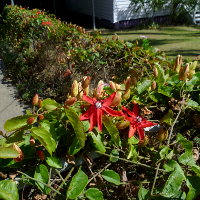 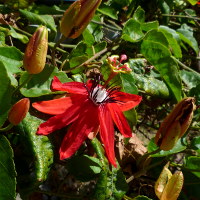 Passiflora coccinea
|
| Petrea | |
| Philodendron | |
| Podranea | |
| Pseudocalymma | see Mansoa |
| Pyrostegia | |
| Quisqualis | |
| Roses | |
| Saritaea | |
| Solandra | |
| Sollya | |
| Stephanotis | |
| Stigmaphyllon | |
| Strongylodon | |
| Strophanthus |
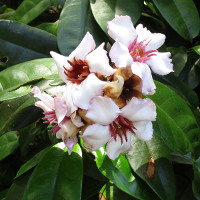 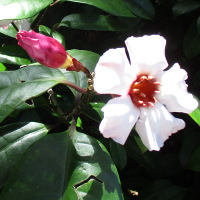 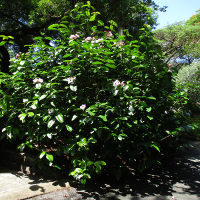 Strophanthus gratus
|
| Tecomanthe | |
| Thunbergia | |
| Trachelospermum | |
| Vigna | |
| Wisteria |
News
Help Extinguish Dutchman's Pipe
Sunshine Coast Regional Council is calling on residents to look out for Dutchman’s pipe. It wants to contain the spread of this invasive vine and eventually eradicate it from the region. Council is currently working with land holders and managers to do just that, notably in the Upper Stanley, Pumicestone, Mooloolah, Maroochy and Mary River catchments. Meanwhile, if you spot the vine anywhere on the Sunshine Coast, the council is requesting that you report it. More information here: Have you seen a Dutchman’s pipe? (December 2020)
Vine identification in Moreton region
Weedy vines can be very damaging to native bushland. Moreton Bay Regional Council has released a new booklet to help residents identify and control pest species. Eighteen local vine species are also featured, including the Richmond Birdwing Vine (food source for caterpillars of the vulnerable Richmond Birdwing butterfly.) "Vines of the Moreton Bay Region" can be downloaded from www.moretonbay.qld.gov.au or collected from customer service centres, libraries, and environmental centres in the region. (December 2008)
